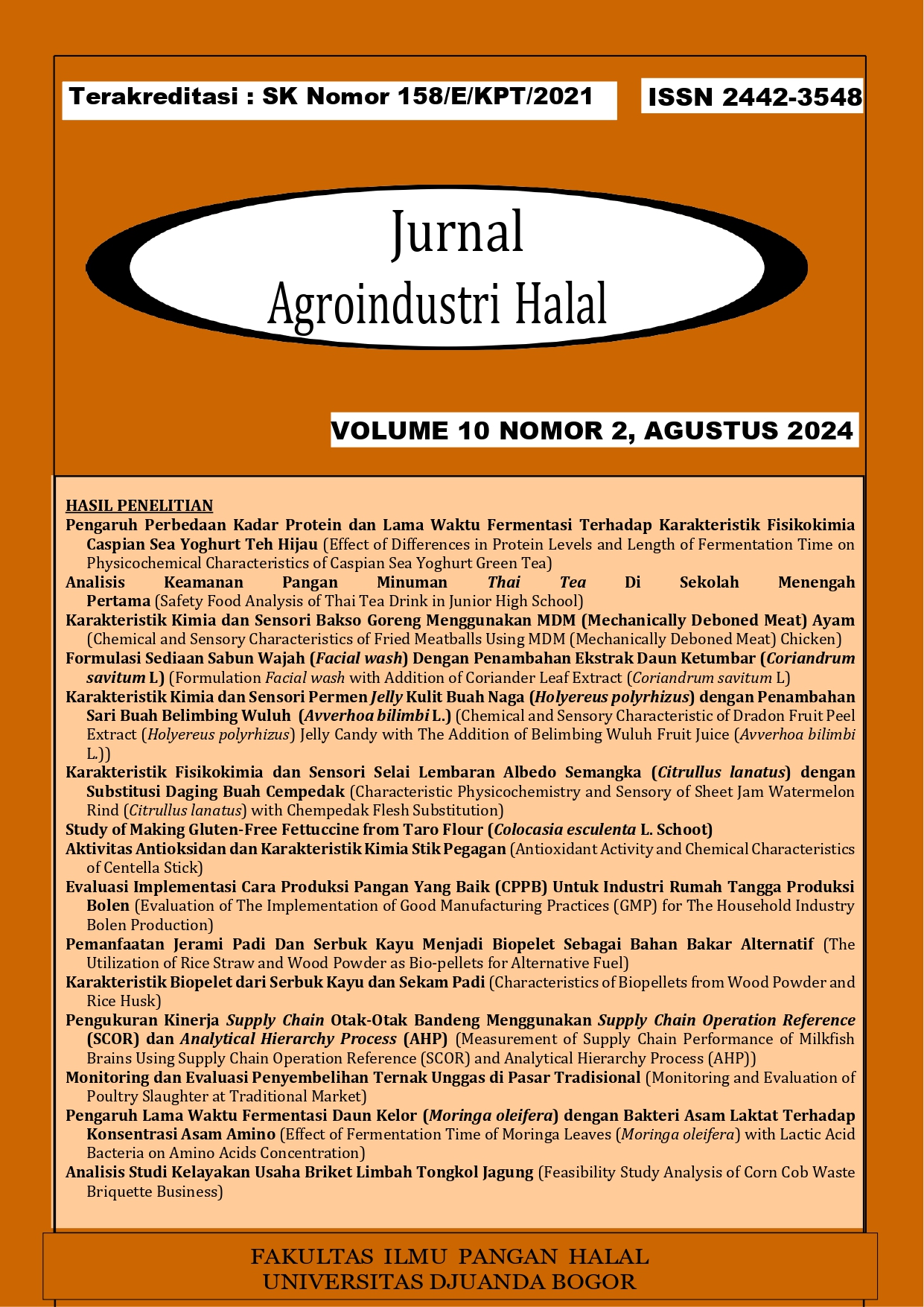PENGARUH LAMA WAKTU FERMENTASI DAUN KELOR (Moringa oleifera) DENGAN BAKTERI ASAM LAKTAT TERHADAP KONSENTRASI ASAM AMINO
DOI:
https://doi.org/10.30997/jah.v10i2.8468Keywords:
Asam amino, Amino acid, Bakteri Asam Laktat (BAL), Daun kelor, Fermentasi, Fermentation, Lactic Acid Bacteria (LAB), Moringa leavesAbstract
Moringa (Moringa oleifera) is a nutrient-densed food that can be used as a food source and possess pharmacological properties. Fermented Moringa has a better amino acid profiles and potentially has a greater digestibility. Nevertheless, the effect of lactic acid bacteria as fermentation culture on Moringa’s amino acid profiles is warrant for investigation. The purpose of this study was to determine the effect of the Moringa’s fermentation with lactic acid bacteria on its nutritional value, especially amino acid. In this study, Moringa leaves were fermented with lactic acid bacteria for 0, 24, and 48 hours. Amino acid concentrations with fermentation 0, 24, and 48 hours respectively were 1007.94 mg/kg, 1304.13 mg/kg, and 521.12 mg/kg, where the highest concentration of amino acids was in Moringa leaves which were fermented for 24 hours. The concentrations of various amino acids in Moringa leaves were measured by High Performance Liquid Chromatography. The best treatment was 24 hours of fermentation, where the total amino acid (TAA) was 1304.13 mg/kg.
References
Aznury, M., Margerty, E., Melianti, Sofiah, Yuniar, & Awwaliyah, S. (2021). Effect of Fermentation Time and Percentage of Moringa (Moringa oleifera) Flour Variations on Vitamin C of Yogurt. Proceedings of the 4th Forum in Research, Science, and Technology (FIRST-T1-T2-2020), 7, 376–383. https://doi.org/10.2991/ahe.k.210205.063
BPOM. (2019). PEDOMAN EVALUASI MUTU GIZI DAN NON GIZI PANGAN.
Choińska, R., Piasecka-Jóźwiak, K., Woźniak, Ł., Świder, O., Bartosiak, E., Bujak, M., & Roszko, M. Ł. (2022). Starter culture-related changes in free amino acids, biogenic amines profile, and antioxidant properties of fermented red beetroot grown in Poland. Scientific Reports, 12(1). https://doi.org/10.1038/s41598-022-24690-9
Correia, I., Nunes, A., Guedes, S., Barros, A. S., & Delgadillo, I. (2010). Screening of lactic acid bacteria potentially useful for sorghum fermentation. Journal of Cereal Science, 52(1), 9–15. https://doi.org/10.1016/j.jcs.2010.02.011
D’Este, M., Alvarado-Morales, M., & Angelidaki, I. (2018). Amino acids production focusing on fermentation technologies – A review. Biotechnology Advances, 36(1), 14–25. https://doi.org/10.1016/J.BIOTECHADV.2017.09.001
Dewi, R., Huda N, Ahmad R, & Abdullah W. (2010). Mutu Protein Dendeng Ikan Hiu yang Diolah Dengan Cara Pengeringan Berbeda | Dewi | Jurnal Pascapanen dan Bioteknologi Kelautan dan Perikanan. http://www.bbp4b.litbang.kkp.go.id/jurnal-jpbkp/index.php/jpbkp/article/view/429/275
Fadlallah, O. E., El Tinay, A. H., & Babiker, E. E. (2010). Biochemical characteristics of sorghum flour fermented and/or supplemented with chickpea flour. World Academy of Science, Engineering and Technology, 37(1), 1087–1091.
Fajri, Y., Sukarso, A. A., Ayu, D., & Rasmi, C. (2014). Fermentasi Ikan Kembung (Rastrelliger sp.) dalam Pembuatan Peda dengan Penambahan Bakteri Asam Laktat (BAL) yang Terkandung dalam Terasi Empang pada Berbagai Konsentrasi Garam.
Hendarto, D. R., Handayani, A. P., Esterelita, E., & Handoko, Y. A. (2019). MEKANISME BIOKIMIAWI DAN OPTIMALISASI Lactobacillus bulgaricus DAN Streptococcus thermophilus DALAM PENGOLAHAN YOGHURT YANG BERKUALITAS BIOCHEMISTRY MECHANISM AND OPTIMIZATION Lactobacillus bulgaricus AND Streptococcus thermophilus IN PROCESSING QUALITY YOGHURT. In J. Sains Dasar (Vol. 8, Issue 1).
Khasanah, V., & Astuti, P. (2019). Pengaruh Penambahan Ekstrak Dau Kelor (Moringa Oleifera) Terhadap Kualitas Inderawi Dan Kandungan Protein Mie Basah Substitusi Tepung Mocaf. Jurnal Kompetensi Teknik, 11(2), 15–21.
Li, Y., Wang, J., Wang, T., Lv, Z., Liu, L., Wang, Y., Li, X., Fan, Z., & Li, B. (2022). Differences between Kazak Cheeses Fermented by Single and Mixed Strains Using Untargeted Metabolomics. Foods, 11(7). https://doi.org/10.3390/foods11070966
Liputo, S. A., Berhimpon, S., & Fatimah, D. F. (2013). Analisa Nilai Gizi Serta Komponen Asam Amino dan Asam Lemak Dari Nugget Ikan Nike (Awaous melanocephalus) dengan Penambahan Tempe. Chemistry Progress, 6(1), 38–44. https://ejournal.unsrat.ac.id/v3/index.php/chemprog/article/view/2070/1643
Purwaningsih, S., Salamah, E., & Apriyana, G. P. (2013). PROFIL PROTEIN DAN ASAM AMINO KEONG IPONG-IPONG (Fasciolaria salmo) PADA PENGOLAHAN YANG BERBEDA. Jurnal Gizi Dan Pangan, 8(1), 77. https://doi.org/10.25182/jgp.2013.8.1.77-82
Purwantiningsih, T. I., Bria, M. A. B., & Kia, K. W. (2022). Levels Protein and Fat of Yoghurt Made of Different Types and Number of Cultures. Journal of Tropical Animal Science and Technology, 4(1), 66–73. https://doi.org/10.32938/jtast.v4i1.967
Sakinah, N., Prangdimurti, E., & Palupi, N. S. (2019). Kandungan Gizi Dan Mutu Protein Tepung Biji Kelor Terfermentasi. Jurnal Teknologi Dan Industri Pangan, 30(2), 152–160. https://doi.org/10.6066/jtip.2019.30.2.152
Utami, T., Cindarbhumi, A., Khuangga, M. C., Rahayu, E. S., Cahyanto, M. N., Nurfiyani, S., & Zulaichah, E. (2020). Preparation of Indigenous Lactic Acid Bacteria Starter Cultures for Large Scale Production of Fermented Milk. Digital Press Life Sciences, 2, 00010. https://doi.org/10.29037/digitalpress.22327
Waqas Ali, M., Zahaib Ilays, M., Tariq Saeed, M., & Shin, D.-H. (2020). Comparative assessment regarding antioxidative and nutrition potential of Moringa oleifera leaves by bacterial fermentation. https://doi.org/10.1007/s13197-019-04146-1
Wolfe, R. R. (2017). Branched-chain amino acids and muscle protein synthesis in humans: myth or reality? https://doi.org/10.1186/s12970-017-0184-9
World Health Organization. (2007). Protein and amino acid requirements in human nutrition. Report of a Joint WHO/FAO/UNU Expert Consultation. In WHO Technical Report Series.
Zhang, X., Sun, Z., Cai, J., Wang, J., Wang, G., Zhu, Z., & Cao, F. (2020). Effects of dietary fish meal replacement by fermented moringa (Moringa oleifera Lam.) leaves on growth performance, nonspecific immunity and disease resistance against Aeromonas hydrophila in juvenile gibel carp (Carassius auratus gibelio var. CAS III). Fish and Shellfish Immunology, 102, 430–439. https://doi.org/10.1016/j.fsi.2020.04.051
Downloads
Published
How to Cite
Issue
Section
License
Copyright (c) 2024 Annisa Sekar Aprisa, Dudung Angkasa, S.Gz., M.Gizi., RD, Putri Ronitawati, SKM, M.Si, RD, Reza Fadhilla, S.TP, M.Si, Prita Dhyani Swamilaksita, S.P, M.Si

This work is licensed under a Creative Commons Attribution-ShareAlike 4.0 International License.
Authors who publish with Jurnal Agroindustri Halal agree to the following terms:
- Authors retain copyright and grant the journal right of first publication with the work simultaneously licensed under a Creative Commons Attribution 4.0 International License that allows others to share the work with an acknowledgement of the work's authorship and initial publication in Jurnal Agroindustri Halal.
- Authors are able to enter into separate, additional contractual arrangements for the non-exclusive distribution of the journal's published version of the work (e.g., post it to an institutional repository or publish it in a book), with an acknowledgement of its initial publication in Jurnal Agroindustri Halal.
- Authors are permitted and encouraged to post their work online (e.g., in institutional repositories or on their website) prior to and during the submission process, as it can lead to productive exchanges, as well as earlier and greater citation of published work









